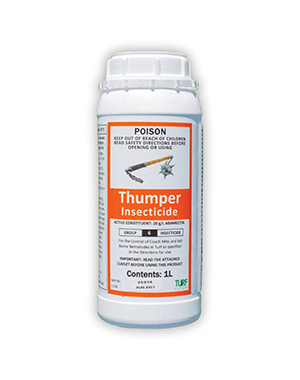What Are Parasitic Wasps & How Can They Help Your Lawn?
The name ‘Parasitic Wasps’ is unnecessarily terrifying, because the truth is that the presence of these bugs around your home might be both an indicator of an outbreak of ...

 Insecticides are products containing ingredients that will kill, control, or repel pest insects.
Insecticides are products containing ingredients that will kill, control, or repel pest insects.
They can be made from natural or synthetic agents and act on eggs, larvae, or adult insects that can damage your lawn or garden plants, flowers, and fruit.
As well as causing physical damage from feeding on grass blades or roots, some insect pests spread diseases that can affect the health and appearance of your lawn.
There’s a long list of pest insects that attack lawns. It includes beetles, moths, grasshoppers, caterpillars, and grubs.
Among the most common are Lawn Grubs, which is the collective name given to the larvae of a number of insects.
They’re more likely to strike in spring and summer when your lawn is growing quickly and at its healthiest – making it especially tasty to insects!
Lawn Grubs live underground, where they eat the roots and leaves. This can make it difficult to tell your lawn is in danger before they’ve caused substantial damage.
There’s more information about how best to deal with Lawn Grubs here.
There are three main types of insecticide: liquid, granular, and sprays.
Each has its pros and cons.
Liquid – Emulsifiable concentrates are easy to use and measure and will not block screens or nozzles. Flowables contain finely ground particles in a liquid carrier. Both are hazardous if spilled and should always be handled with care.
Granular – Dry ready-to-use materials that are less likely to drift. They can be more expensive but are the easiest and cheapest to apply using an inexpensive hand spreader.
Spray – A premixed solution packed into an aerosol can that delivers the contents as a spray or mist. Not suitable for treating large areas.
 Some types of grass are more vulnerable to damage from insecticide than others.
Some types of grass are more vulnerable to damage from insecticide than others.
Always read the label first, before treating your lawn with any product.
If a product is not suitable for use on your grass type, look for an alternative that is safe or you risk causing further damage.
The label will provide all the information you need about how and when or when not to apply the product. Some will need to be watered in by rain or irrigation, while others should not.
The label also will indicate when you can expect to see results and what to do if a repeat application is needed.
It is generally best to apply insecticides when conditions are cooler and dry, and late in the afternoon or evening when both grubs and adults are most likely to be active.
Avoid application during or within 24 hours of a hot spell and aim to get on top of pests before their populations have the chance to explode and cause even more damage.
Ground-dwelling grubs and beetles feed on the leaves and roots, which can weaken your lawn and result in it developing a sponge-like texture. In severe cases, you’ll be able to lift or roll the lawn like a rug because the roots can’t hold on.
Brown patches can develop from this damage and persist through winter when the lawn is slower to grow and recover.
 Increased moth and beetle activity is a sign that they’re laying eggs for the next generation of larvae that will cause feeding damage to your lawn for several weeks before transforming into an adult moth or beetle.
Increased moth and beetle activity is a sign that they’re laying eggs for the next generation of larvae that will cause feeding damage to your lawn for several weeks before transforming into an adult moth or beetle.
Increased bird activity, especially at dusk and dawn, can indicate the presence of Lawn Grubs which many bird species love to eat.
There are two easy ways to confirm there’s a problem and check which insects are responsible.
You can lay a wet towel, hessian sack, or a carpet offcut on a suspicious section of the lawn overnight. Lift it in the morning and see which, if any, larvae are lurking under it.
 Another method is to mix a bucket of soapy water and pour it over an affected area at dusk or dawn. Grubs are most likely to be active at this time of day and if there’s any present, they will come to the surface in the next 10-20 minutes.
Another method is to mix a bucket of soapy water and pour it over an affected area at dusk or dawn. Grubs are most likely to be active at this time of day and if there’s any present, they will come to the surface in the next 10-20 minutes.

Syngenta Acelepryn GR 10kg provides granular control of seasonal Lawn Grubs and Caterpillars in a single application.
SHOP NOW
PCT Fivestar 1L liquid has a low odour and offers superior control of insect pests.
SHOP NOW
Indigo ProForce Recruit 200SC 1L is a broad spectrum selective Insecticide that delivers superior results against a variety of beetles.
SHOP NOW
Indigo ProForce Rumbler 100SC 1L is a broad spectrum insecticide in a suspension concentrate formulation that is effective on a range of insects.
SHOP NOW
Monarch G 2.5kg provides fast-acting control of a wide range of insects.
SHOP NOW
Thumper 1L is a fast-acting insecticide that provides long residual control of Mites and soil-borne Nematodes.
SHOP NOW
Indigo ProForce Malice Duo 1L is a combination insecticide for the control of Couch Mite in Couch lawns and is suitable only for Couch turf.
SHOP NOWThe myhomeTURF shop has a range of insecticides suitable for use in Buffalo, Couch, Zoysia and Kikuyu lawns. You can browse them at myhomeTURF’s online store.